





PHOTO GALLERY

Photos by Len Blumin
1. Great Horned Owl
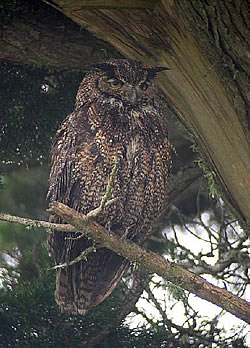
Always fun to spot, this male Great Horned Owl (GHO) is staring balefully at our group from his perch in a Cypress at the Fish Docks. Foggy day, and the deep shade only accentuated the darkness commonly seen in the western race of GHO. Sibley gives the size of the Great GHO as 22" long and weighing 3.1 lb., with wingspan of 44". Formidable bird indeed! This male has been in the current location for about four years, but GHOs have occupied these trees for decades, fledging many young.
The GHO is found throughout the US and Canada, and is related to the Eagle Owl of Eurasia. In fact "Bubo" is latin for Eagle Owl. A formidable predator, it will take just about any mammal around smaller than a deer. Prey items listed in the Encyclopaedia of NA Birds include: rabbits, rats, skunks (loves 'em), squirrels, muskrats, opossum, and porcupines. Not to mention domestic cats, large snakes, grebes, ducks, geese, pheasant, owls, crows and all manner of larger insects.
2. Cattle Egret Chicks
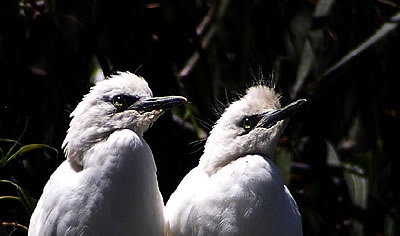
I think one of the great things about birding is that those who have developed great skill and knowledge in the field are so willing to teach others, and you quickly learn that the accumulated wisdom of a careful observer is so much more valuable than just looking in a field guide.
In this case, who better to ask about an egret ID than John Kelly, ACR's research director and all-round good guy. I sent the photos to John, and he kindly helped nail down the ID of the egret chicks. It seems that egret chicks of several species have similar features, and the best way to be sure is to ID the adult that is feeding them! Cattle and Snowy Egret chicks both have dark bills, and the Snowy chicks' bills are thick and short like the Cattle, so no help there. After reviewing the photos, John favored Cattle Egret, but added that the one feature that would clearly distinguish the species would be the presence of a buffy forehead and/or nape that is sometimes seen on Cattle Egret chicks, and John's sharp eyes detected a hint of color on the forehead of one of these chicks. I darkened the photo a bit, and sure enough, the buffy forehead confirms that these are indeed Cattle Egrets. Thanks, John!
And, btw, ACR is always looking for volunteers to help monitor breeding colonies of herons and egrets in the North Bay. If you have a scope, enthusiasm, and some basic birding skills, then give us a call. (You can call me or Patti at 415-388-4990 and we'll tell you about it).
3. Song Sparrow (Melospiza melodia)
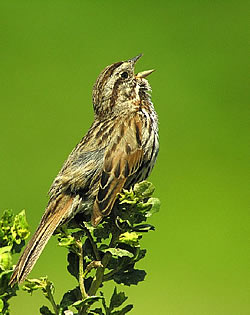
So, how much song does a song sparrow sing? Believe it or not, some field observers addressed that question and did some counting. The Song Sparrow seems like the most vocal bird in the world, but that is probably because they are so ubiquitous rather than the most tuneful. Their song may not be as exuberant as the House Finch, but the introductory notes of the tune always make me stop and listen, and the variations that follow can be quite varied. See Aud. Soc. Ency. of No. American Birds (Terres) for a good discussion of why birds sing.
Almost forgot - they sing their primary song 1500 times a day, give or take. I can believe it, as I walked around the first pond at Las Gallinas today there was a boastful singer on almost every Coyote Bush.
4. Willet
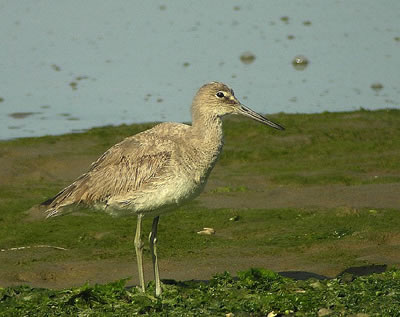
By now (May 10) most shorebirds have left, and there is a bit of a lull as the neotropical songbirds slowly filter in. Still present along the coast are some of the larger shorebirds like Willet and Whimbel. The Willet (Tringa semipalmata) is named for its call, like Killdeer. Easy bird to learn, because it is large and gray, with a strong dark bill which appears pretty straight, although it actually curves slightly upward. A white ring sets off the eye, similar to the tringas, and the gray legs sometimes have a slight greenish tinge, as here. Noisy bird, and sometimes bossy of other shorebirds, but always fun to watch. Gets a bit more dressy in breeding plumage, but this one seems late in donning his best outfit. His semipalmated (partly webbed) feet are hidden in the algae. Actually, males and females are alike, with the female perhaps slightly bigger. They can afford to stay longer as their trip to inland nesting sites is not as far as for many of the smaller shorebirds that headed far north.
Taken at Bolinas Lagoon, May 10, 2006. Swaro 80 scope with 30x SW eyepiece, DCA, Coolpix 8400 camera. The 8400 has a neat little infrared remote shutter release that helps minimize movement.
5. White-Winged Scoter
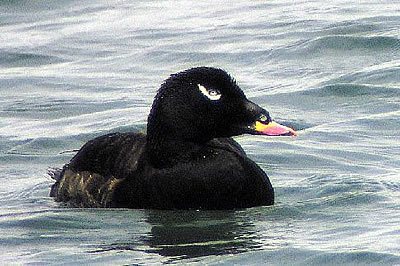
Some birds can be identified from just a small glimpse of a part of their body, as with the eye of the White-winged Scoter, Melanitta fusca deglandi. Melanitta means "black duck". Fusca means dark or dusky, but that seems redundant. Doctor Come Damien Degland was a French ornithologist after whom this subspecies was named. In Europe they have the similar Velvet Scoter, M. fusca fusca, which I guess is three times darker than black.
Enough of names. This diving duck is one of 3(5) scoters in the world, all of which we can see locally on the west coast, sometimes swimming together. Rich S relates that the White-winged Scoter has become less common in the southern extend of its range (Northern California), for reasons unknown. The White-winger may not be as gaudy as the Surf Scoter, but surely is more sublime, despite the preposterous bill. You've gotta love the eye make-up and white iris! Not shown here are the white wing patches, but .....
Taken today on Bodega Bay, Campbell's Cove. Other scoters are the Surf Scoter and Black Scoter/Common Scoter.
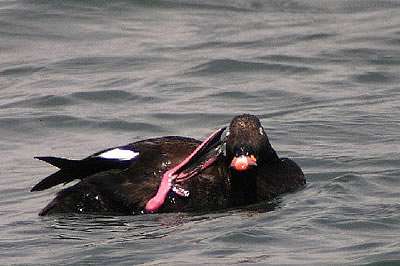
The photos in the field guides rarely shown the feet. Check out the monster pink foot on this guy, as he scratches his face (yes, the male is the colorful one, as in most ducks). And now we get to see the white wing patch too.
TOWHEE.NET: Harry Fuller, 820 NW 19th Street, McMinnville, OR 97128
website@towhee.net